Wikipedia:Picture of the day/October 2007
|
Featured picture tools: |
These featured pictures, as scheduled below, appeared as the picture of the day (POTD) on the English Wikipedia's Main Page in October 2007. Individual sections for each day on this page can be linked to with the day number as the anchor name (e.g. [[Wikipedia:Picture of the day/October 2007#1]] for October 1).
You can add an automatically updating POTD template to your user page using {{Pic of the day}} (version with blurb) or {{POTD}} (version without blurb). For instructions on how to make custom POTD layouts, see Wikipedia:Picture of the day.
October 1
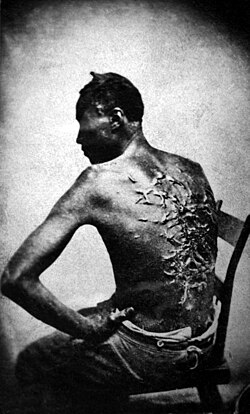
|
Scars of a whipped slave named Peter, photo taken at Baton Rouge, Louisiana, 1863. In his own words, "Overseer Artayou Carrier whipped me. I was two months in bed sore from the whipping. My master come after I was whipped; he discharged the overseer." The slave pictured here escaped from a plantation in Mississippi, made his way to Union forces, and joined the U.S. Army at the Union garrison located at Baton Rouge. Slavery in the United States began soon after the English colonists first settled in North America. From about the 1640s until 1865, people of African descent were legally enslaved within the boundaries of the present U.S. mostly by whites, but also by a comparatively tiny number of American Indians and free blacks. By 1860, the slave population in the U.S. had grown to 4 million. Photo credit: McPherson and Oliver
Recently featured:
|
October 2
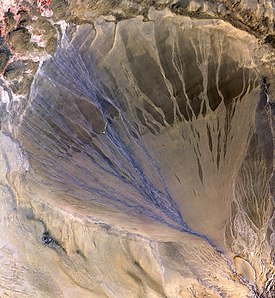
|
A vast alluvial fan blossoms across the desolate landscape between the Kunlun and Altun mountain ranges that form the southern border of the Taklamakan Desert in China's Xinjiang Province. The left side of this satellite image is the active part of the fan, and appears blue from water currently flowing in the many small streams. Photo credit: ASTER
Recently featured:
|
October 3

|
|
This approximate true-color image taken by the panoramic camera on the Mars Exploration Rover Opportunity shows the 130-meter (427 ft) wide impact crater known as "Endurance". This image mosaic consists of a total of 258 individual images. Photo credit: Mars Exploration Rover Opportunity
Recently featured:
|
October 4
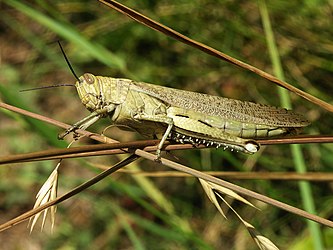
|
The Egyptian Grasshopper (Anacridium aegyptium) is one of a dozen species that may be called a locust during its swarming phase. Common in the southern Europe and around Mediterranean, it is similar to the gregarious phase of the desert locust (Schistocerca gregaria), but is clearly distinguished by the striped eyes and, unlike that species, causes little damage. Photo credit: Joaquim Alves Gaspar
Recently featured:
|
October 5
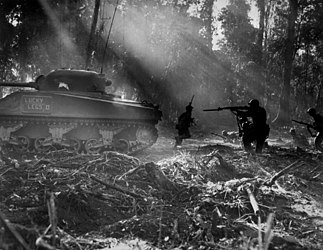
|
U.S. Army soldiers during the Bougainville campaign (in the Solomon Islands) during World War II. Japanese forces tried infiltrating the U.S. lines at night; at dawn, the U.S. soldiers would clear them out. In this picture, infantrymen are advancing in the cover of an M4 Sherman tank. Photo credit: United States Army
Recently featured:
|
October 6
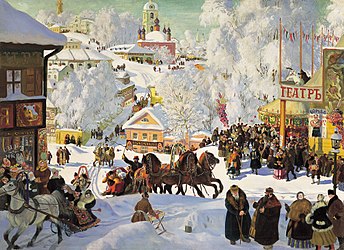
|
Maslenitsa, a 1919 painting depicting the carnival of the same name, which takes place the last week before Great Lent. The painting encompasses a broad range of things associated with Russia, such as snowy winter weather, a troika, an Orthodox church with onion domes. Painted in the aftermath of the October Revolution, the canvas was intended as a farewell to the unspoilt "Holy Russia" of yore. Artist: Boris Kustodiev
Recently featured:
|
October 7
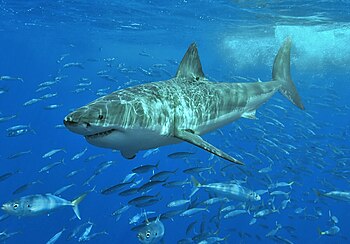
|
A great white shark (Carcharodon carcharias) swims among a shoal of mackerel at Isla Guadalupe, Mexico. Great white sharks' reputation as ferocious predators is well-earned, yet they are not indiscriminate "eating machines". Although the 1975 film Jaws provided the shark with the image of a "man eater" in the public mind, they typically do not target humans as prey. Photo credit: Terry Goss
Recently featured:
|
October 8

|
NOTE: File:Einsatzgruppen_Killing.jpg was determined to be non-free and therefore ineligible to be Picture of the Day. A member of Einsatzgruppe D is just about to shoot a Jewish man kneeling before a filled mass grave in Vinnitsa, Ukraine, in 1942. The photograph was found in the personal album of a German soldier, with the inscription on the back reading, "The last Jew in Vinnitsa". Present in the background are members of the German Army, the German Labor Service, and the Hitler Youth. The Einsatzgruppen were paramilitary groups operated by the SS before and during World War II. According to their own records, they were responsible for killing over one million Jewish people, almost exclusively civilians. Photo credit: Unknown, courtesy of the USHMM
Recently featured:
|
October 9
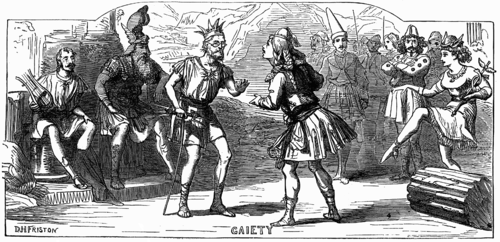
|
|
Detail from "The Pantomimes" by D.H. Friston from the January 6, 1872 Illustrated London News, showing a scene from Thespis, the first Gilbert and Sullivan opera. This is one of the few surviving contemporary images of the production. Illustration credit: D.H. Friston
Recently featured:
|
October 10
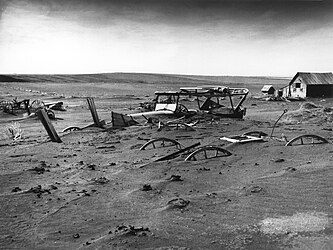
|
Buried machinery in a barn lot, Dallas, South Dakota, United States, due to Dust Bowl conditions, May 1936. Dust storms from 1930–1939 caused major ecological and agricultural damage to American and Canadian prairie lands. This ecological disaster was a result of drought conditions coupled with decades of extensive farming using techniques that promoted erosion. Photo credit: Sloan, USDA
Recently featured:
|
October 11
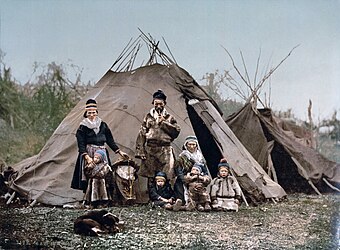
|
A Sami family in Norway around 1900. Also known as Lapps, the Sami are among the largest group of indigenous peoples of Europe, inhabiting Sápmi, which today encompasses parts of northern Sweden, Norway, Finland and the Kola Peninsula of Russia. This image is a photochrom (a hand-coloured monochrome plate), a common practice at the time. Photo credit: Detroit Publishing Co.
Recently featured:
|
October 12
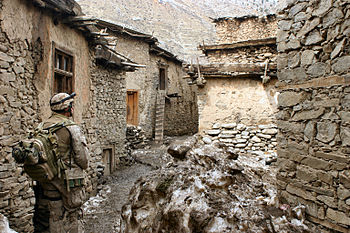
|
Hospital Corpsman 2nd Class Alonzo Gonzales with Kilo Company, 3rd Battalion, 3rd Marine Regiment, walks through an alley in Methar Lam, Afghanistan, looking for signs of sickness or disease. His clothing is patterned with MARPAT, a modern form of military camouflage. Photo credit: Cpl. James L. Yarboro, USMC
Recently featured:
|
October 13

|
The Soyuz TMA-9 mission on the Soyuz rocket launches from the Baikonur Cosmodrome in Kazakhstan, September 18, 2006 carrying a new crew to the International Space Station. The spaceflight was the first time since before the Columbia accident that twelve humans have been in space simultaneously; three aboard the International Space Station (Expedition 13), three aboard Soyuz TMA-9, and six aboard Space Shuttle Atlantis, flying mission STS-115. The observer in the lower right gives a distorted sense of scale because the rocket is actually 46.1 metres (151.2 ft) tall, although it appears to be much smaller here. Photo credit: Bill Ingalls, NASA
Recently featured:
|
October 14
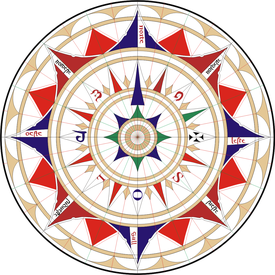
|
Replica of a compass rose from the chart of Jorge de Aguiar (1492), the oldest known signed and dated Portuguese nautical chart. It is a 32 point compass rose, meaning that the lines that radiate from its centre indicate 32 different geographic directions. The original chart is in the Beinecke Library at Yale University. Image credit: Joaquim Alves Gaspar
Recently featured:
|
October 15

|
|
A view of Portland, Oregon from the east waterfront depicting the skyline of the downtown district. The Hawthorne Bridge is prominent on the left. Although Portland is Oregon's largest city, it is not the state capital; that designation falls to Salem. Photo credit: Eric Baetscher
Recently featured:
|
October 16
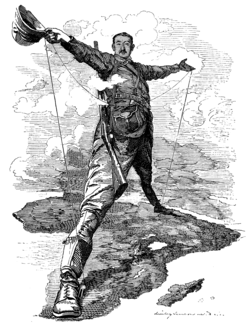
|
The Rhodes Colossus is an iconic editorial cartoon of the Scramble for Africa period, depicting British colonialist Cecil John Rhodes as a giant standing over the continent, after his announcement of plans to extend an electrical telegraph line from Cape Town to Cairo. Rhodes is shown in a visual pun as the ancient Greek statue the Colossus of Rhodes, with his right foot in Cape Town and his left in Cairo, illustrating his broader "Cape to Cairo" concept for British domination of Africa. Illustration: Edward Linley Sambourne
Recently featured:
|
October 17

|
A crying Sudeten woman salutes Adolf Hitler as German forces sweep into Czechoslovakia, October 1938. Originally published in the Völkischer Beobachter, it supposedly showed the intense emotions of joy which swept the populace as Hitler drove through the streets of Cheb, 99% of whose inhabitants were ardently pro-Nazi Sudeten Germans at the time. In contrast, when the photo was published in the U.S., it was captioned, "The tragedy of this Sudeten woman, unable to conceal her misery as she dutifully salutes the triumphant Hitler, is the tragedy of the silent millions who have been 'won over' to Hitlerism by the 'everlasting use' of ruthless force." It is unknown what the true circumstances surrounding the photo are. Photo credit: Völkischer Beobachter
Recently featured:
|
October 18
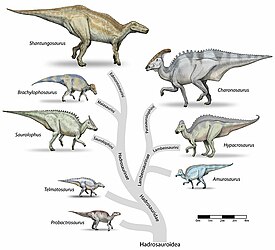
|
Representative dinosaurs of the Hadrosauroidea superfamily. The family Hadrosauridae contains the dinosaurs commonly known as "duck-billed" dinosaurs. They were ubiquitous herbivores during the Cretaceous period, and prey to theropoda such as Tyrannosaurus. The individual drawings represent typical genera. All these groups were alive in the late Cretaceous, and are generally known only from a single fossil site. Animals are shown to scale. Image credit: Debivort
Recently featured:
|
October 19
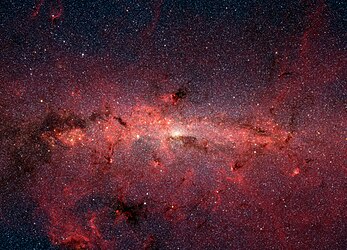
|
This infrared image shows hundreds of thousands of stars crowded into the swirling core of our spiral Milky Way galaxy. In visible-light pictures, this region cannot be seen at all because cosmic dust lying between Earth and the galactic center blocks our view. Photo credit: Spitzer Space Telescope
Recently featured:
|
October 20
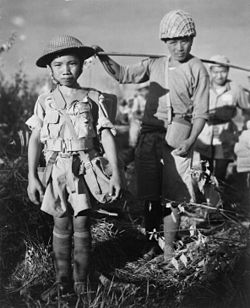
|
This Chinese child soldier, age 10, with heavy pack, is a member of an army division returning to China following the capture of Myitkyina airfield, Burma, under the allied command of US Major General Frank Merrill in May 1944. Chinese and allied troops had earlier crossed through the treacherous jungle of the Kumon Bum Mountains before attacking Japanese troops to the south. A number of international conventions have since come into effect that try to limit the participation of children in armed conflicts. However, according to Human Rights Watch, as many as 300,000 children remain direct participants in war in over twenty countries around the world today. Photo credit: U.S. Army Signal Corps
Recently featured:
|
October 21
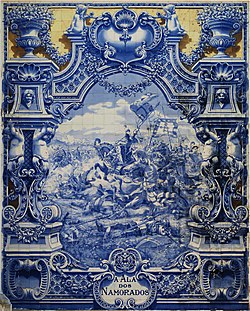
|
Panel of azulejo (Portuguese blue glazed tiles) by artist Jorge Colaço (1922) representing an episode of the Battle of Aljubarrota (1385) between the Portuguese and Castilian armies. The Ala dos Namorados ("Wing of the fiancés") depicted in this scene was the left wing of the Portuguese defense formation. Photo credit: Joaquim Alves Gaspar
Recently featured:
|
October 22
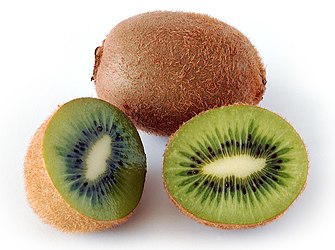
|
The kiwifruit is the edible fruit of a cultivar group of Actinidia deliciosa and hybrids between this and other species in the same genus. In North America, South America and Europe, it is commonly known as "kiwi," the same name as the bird. Originally known as the "Chinese Gooseberry" or "Melonette", the fruit was renamed for marketing reasons after New Zealand's national symbol due to a passing similarity to the small, furry-looking creature. Photo credit: André Karwath
Recently featured:
|
October 23
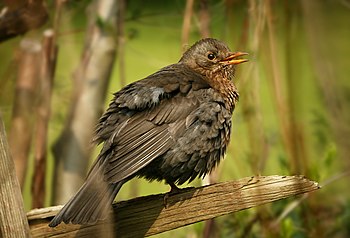
|
A young fluffed up female Blackbird (Turdus merula). Unlike males, who are all black except for a yellow eye-ring and bill, females have brown plumage and a brown beak. Blackbirds are common in woods and gardens over all of Europe and much of Asia south of the Arctic Circle. Females are aggressive in the spring when competing with others for good nesting territory. Photo credit: Daniel Schwen
Recently featured:
|
October 24
|
The first message used to publicly demonstrate the Morse electrical telegraph. The transmitted message reads, in Morse Code: "What hath God wrought". A handwritten notation on the top of the paper strip reads, "This sentence was written from Washington by me at the Baltimore Terminus at 8.h 45 min. A.M. on Friday May 24.th 1844, being the first ever transmitted from Washington to Baltimore by Telegraph and was indited by my much loved friend Annie G. Ellsworth. Sam F. B. Morse. Superintendent of Elec. Mag. Telegraphs." Message credit: Samuel F. B. Morse |
October 25
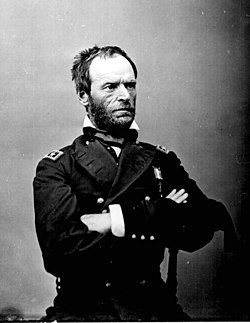
|
Major General William Tecumseh Sherman of the Union Army in May 1865. The black ribbon around his left arm is a sign of mourning over Abraham Lincoln's death. During the American Civil War, Sherman received recognition for his outstanding command of military strategy and criticism for the harshness of the "scorched earth" policies that he implemented in conducting total war against the Confederate States. Photo credit: Mathew Brady
Recently featured:
|
October 26

|
|
A panoramic view of the Melbourne Docklands and the city skyline from Waterfront City looking across Victoria Harbour. Features include (from left): residential and commercial buildings along the harbour at New Quay, the Seven Network digital broadcast centre, some of the original Melbourne docks sheds on Central Pier, the Telstra Dome (Docklands Stadium), apartments and commercial buildings, including the National Australia Bank headquarters. In the background is the Melbourne CBD skyline, including the Rialto Towers and the Eureka Tower. Photo credit: John O'Neill
Recently featured:
|
October 27
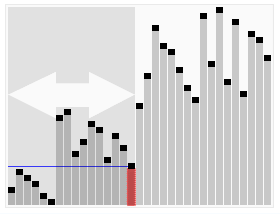
|
An animated image demonstrating the Quicksort algorithm used to sort a list of items in computer programming. First, a pivot is selected from the list, then the list is partitioned so that the values greater than the pivot come after it and those of lower value come before it. This act is recursively performed until the entire list is sorted. Image credit: RolandH
Recently featured:
|
October 28
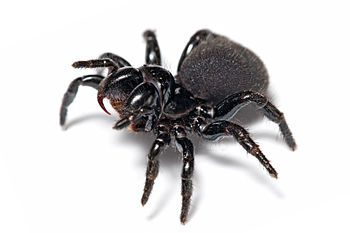
|
A female mouse spider (Missulena bradleyi). The name derives from an old belief, now known to be false, that the spiders dig deep burrows similar to mice. However, they do live in burrows covered with trapdoors, which can extend to nearly 30 centimetres (11.8 in) in depth. There are 11 known species; all but one of them are indigenous to Australia. This specimen is approximately 25 millimetres (1.0 in) in length. Photo credit: Fir0002
Recently featured:
|
October 29
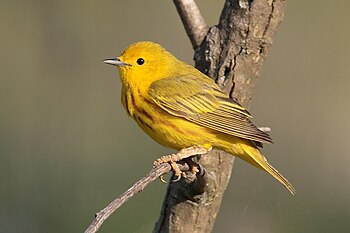
|
The Yellow Warbler (Dendroica petechia) is a New World warbler. It is the most widespread Dendroica warbler, breeding in almost the whole of North America and down to northern South America. Shown here is a member of the aestiva group of subspecies, which average about 11.5 cm (4.5 in) in length and 9 g (0.32 oz) in mass. Photo credit: Mdf
Recently featured:
|
October 30
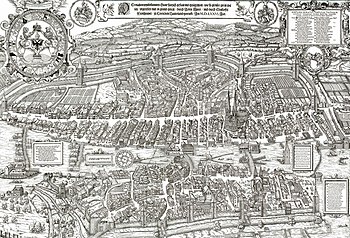
|
The Murerplan, a 1576 woodcut map of Zürich, Switzerland. The caption at the top reads, "The aspect and situation of the ancient and famous town of Zurich / as it has been at this time / drawn and etched / by Jos Murer / and by Christoph Froschauer / printed for the glory of the nation / AD 1576". Map credit: Jos Murer
Recently featured:
|
October 31
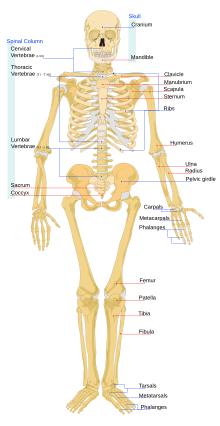
|
An adult female human skeleton. The skeleton provides six main functions: (1) Provide shape and support of the body; (2) provide an attachment surface for muscles and tendons which together enable (3) movement of the body; (4) protection of many vital organs, such as the brain, spinal cord, and heart; (5) the generation of blood cells, which takes place in red bone marrow; and (6) storage of calcium and iron. Image credit: Mariana Ruiz
Recently featured:
|
Picture of the day archives and future dates

